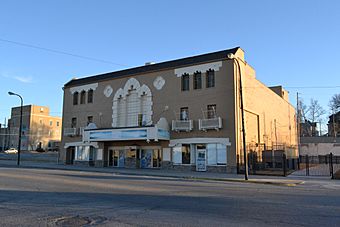Granada Theater (Kansas City, Kansas) facts for kids
Quick facts for kids |
|
|
Granada Theater
|
|
 |
|
| Location | 1013–1019 Minnesota Ave., Kansas City, Kansas |
|---|---|
| Area | Less than 1 acre (0.40 ha) |
| Built | 1929 |
| Architect | Boller Brothers |
| Architectural style | Mission/Spanish Revival |
| MPS | Theaters and Opera Houses of Kansas MPS |
| NRHP reference No. | 05000004 |
| Added to NRHP | February 9, 2005 |
The Granada Theater is a beautiful old movie palace located in the historic downtown area of Kansas City, Kansas. It's in Wyandotte County, Kansas. This theater is designed in a special style called Mission style. This style mixes ideas from Spanish and Moorish buildings.
The front of the theater is very impressive. It has a large, fancy window called a Palladian window. This window is decorated with terracotta pieces on each side. Right below this big window is the main entrance. In the middle of the entrance, you'll find a glass ticket booth. On both the east and west sides of the front, there are small shops on the first floor.
Contents
History of the Granada Theater
How the Theater Was Built
The idea for the Granada Theater came about in 1928. Two people, Ben Gorman and William A. Toplikar, made plans for its construction. They hired a famous architecture firm called the Boller Brothers to design and build it. The theater was completed in 1929.
The Theater's Golden Age and Changes
The Granada Theater was very popular for many years. It was a busy place where people went to watch movies and enjoy entertainment. This success lasted until the 1960s. During this time, television became very popular in homes. This meant fewer people went to traditional movie theaters.
Because of this, the Granada Theater eventually closed its doors. After it closed, different people tried to reopen it. They would try to bring it back to life, but these attempts did not last very long.
Recognizing the Theater's Importance
In 2005, the Granada Theater received a special honor. It was officially listed on the National Register of Historic Places. This means it's recognized as an important historical site. The theater qualified for this list because of its unique architecture. It also earned its spot due to its significant role in the history of the local area.



